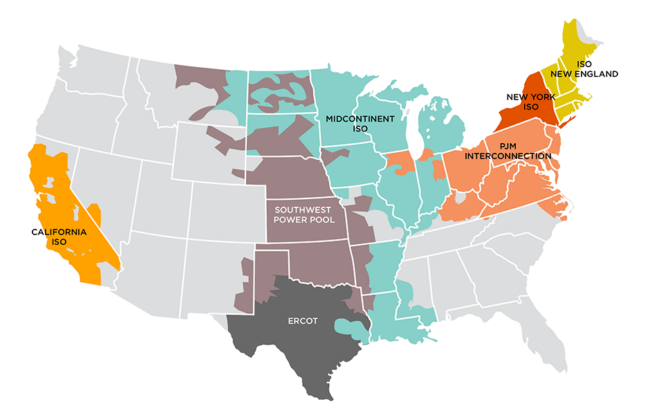By Anne Hedges
 There is a noticeable absence of regional transmission organizations in the West. Image via FERC.
There is a noticeable absence of regional transmission organizations in the West. Image via FERC.
With rising electricity rates and more erratic weather coming as a result of the climate crisis, it’s time to look for new solutions. One such solution is an emerging and rarely-mentioned arena that holds tremendous potential for not only preventing rate increases and increasing energy reliability, but decarbonizing the entire West.
The energy system in the West consists of dozens of individual areas in which a single utility manages the transmission system. If that utility is a publicly-traded monopoly, such as NorthWestern Energy, it is incentivized to decrease competition and to build extremely expensive projects in order to increase revenue for shareholders. Ultimately, that utility wants to sell its product (electricity) for as much as regulators will allow.
This has led to a woefully outdated and inefficient energy system in the West. No single entity oversees the grid system to ensure it evolves to meet modern electricity needs and keep prices reasonable for customers. Even though affordable and reliable electricity is critical to our everyday lives and economy, we have let the system languish.
But change is on the horizon and it comes in the form of a modern and interconnected transmission system. Other areas of the country already engage in energy trading systems within a larger geographic area than is covered by a single utility. These systems, often referred to as independent system operators or regional transmission organizations (RTO), exist in much of the rest of the country to varying degrees of effectiveness, largely depending on the governance structure. There is a strong push to create such an entity in the Western U.S. to allow utilities to take advantage of the tremendous geographic and weather diversity, and make the best use of the energy resources that are available at any point in time.
A market has formed in the West that is already extremely successful: the Western Energy Imbalance Market (EIM), which allows participating utilities to trade energy with other utilities on a short-term basis to meet spikes in demand or sell power elsewhere. Since 2014, the EIM has grown to include 22 participants, including NorthWestern Energy, who have collectively realized over $4.6 billion in benefits in less than a decade. NorthWestern Energy joined the EIM in June 2021 and has already seen benefits of more than $66 million by September 2023.
Much like trading food, cars, and even healthcare across state lines, trading power across a greater geographic landscape just makes sense. While the wind doesn’t always blow in the same location, it’s almost guaranteed to be blowing somewhere else in the region. The wind profiles of nearby states are very different from Montana; for example, the wind in Montana is most productive in winter months, when coastal states have the highest demand for power. But the wind in Washington and Oregon is strongest during summer months, when other states have a higher demand for power. Sharing electricity resources across a greater area allows electricity to be used in a more efficient and affordable manner for all ratepayers.
For example, on September 6, 2022, California faced an intense heat wave and record electricity demand. If customers hadn’t immediately responded to a request to decrease demand, the state may have experienced blackouts. On that day, Montana was not experiencing the same heat wave, opening the possibility that we could have provided power if there had been an effective energy market available.
But trading on a short-term basis is only the start. Many across the region are working furiously to improve the electricity trading system by creating a system where utilities can trade power the day before they need it. The Extended Day Ahead Market (EDAM) would be the logical next step to creating a more affordable and efficient electricity system. It would ideally be followed-up with an RTO, designed and overseen by states, to create the greatest benefit for electricity reliability and customers’ bills.
Trading power across state lines already happens, but it is an inefficient and bilateral system. An organization that oversees the electric grid, helps expedite upgrades to an aging and inadequate transmission system, and helps ensure power is used more efficiently and affordably makes sense. And while an RTO is still a few years away, EDAM is likely to be up and running in the next year or so. The ability of these two market structures to help utilities meet peak demand without building new power plants cannot be overstated.
These market structures need to be a priority in our climate work. Clean energy generation is an important part of decarbonizing, but hooking up to a regional grid can reduce the energy generated (and wasted) across the entire West. The cleanest (and cheapest) energy is that which is not used, so a more efficient method of managing electricity demand could address emissions and air pollution on a truly impactful scale.
This article was published in the December 2023 issue of Down To Earth.

